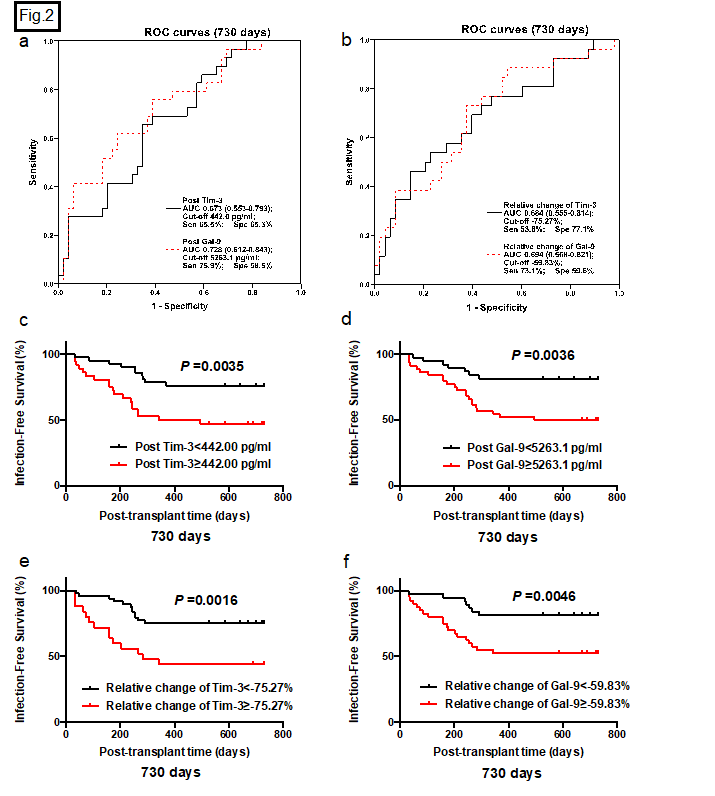Assessment of Serum Tim3 and Gal9 Levels in Predicting the Risk of Infection after Kidney Transplantation
1Department of Nephrology, West China Hospital, Chengdu, China, 2Department of Laboratory Medicine, West China Hospital, Chengdu, China
Meeting: 2019 American Transplant Congress
Abstract number: 255
Keywords: Infection, Kidney transplantation, Risk factors
Session Information
Session Name: Concurrent Session: Biomarkers, Immune Monitoring and Outcomes II
Session Type: Concurrent Session
Date: Monday, June 3, 2019
Session Time: 2:30pm-4:00pm
 Presentation Time: 3:06pm-3:18pm
Presentation Time: 3:06pm-3:18pm
Location: Room 306
*Purpose: Infection remains a major cause of morbidity and mortality after kidney transplantation (KT). However, reliable biomarkers to predict the occurrence of post-transplant infection are lacking. In this study, we aimed to investigate the predictive values of pre- and post-transplant levels of T-cell immunoglobulin and mucin domain-3 (Tim-3) and Galectin-9 (Gal-9), two pleiotropic immunomodulatory molecules that involve in the negative regulation of T cell response, for the early prediction of infection after KT.
*Methods: Serum Tim-3 and Gal-9 were measured with ELISA and Bio-Plex® suspension array system, respectively, at pre-transplant and 30 days after transplantation in 95 KT recipients (KTRs). The decline rates of Tim-3 and Gal-9 were calculated relative to pre-transplant levels. Receiver-operating characteristic curves (ROC) and Cox regression models were utilized to assess the predictive performances and the impacts of Tim-3 and Gal-9 on the occurrence of infection during first two years after KT.
*Results: KTRs with infection history had significantly higher levels of Tim-3 and Gal-9 on day 30, and lower relative decrease rates of Tim-3 and Gal-9 compared to non-infected recipients, while no difference was observed between two groups regarding pre-transplant levels (Fig.1). The AUCs for predicting 2-year post-transplant infection were 0.673 and 0.728 for Tim-3 and Gal-9 on day 30, 0.684 and 0.694 for relative decrease rates of Tim-3 and Gal-9, respectively (Fig.2a-2b). After adjusting for potential confounders, Tim-3, Gal-9 on day 30 and relative decrease rates of Gal-9 remained as independent risk factors for post-transplant infection during follow-up period (Hazard ratios: 3.06, 2.76 and 2.76, respectively)(Fig.2c-2f).
*Conclusions: Post-transplant Tim-3 and Gal-9 levels on day 30 were novel and potentially valuable predictors for infection during first 2 years after transplantation, while pre-transplant Tim-3 and Gal-9 showed no predictive power to such complication. In addition, the relative decrease rate of Gal-9, not Tim-3, was useful in identifying the KTRs with high risk of infection.
To cite this abstract in AMA style:
Shi Y, li y, Li Y, Yan L, Tang J, Wu X, Bai Y, An Y, Dai B, Yang C, Wang L. Assessment of Serum Tim3 and Gal9 Levels in Predicting the Risk of Infection after Kidney Transplantation [abstract]. Am J Transplant. 2019; 19 (suppl 3). https://atcmeetingabstracts.com/abstract/assessment-of-serum-tim3-and-gal9-levels-in-predicting-the-risk-of-infection-after-kidney-transplantation/. Accessed December 27, 2025.« Back to 2019 American Transplant Congress


